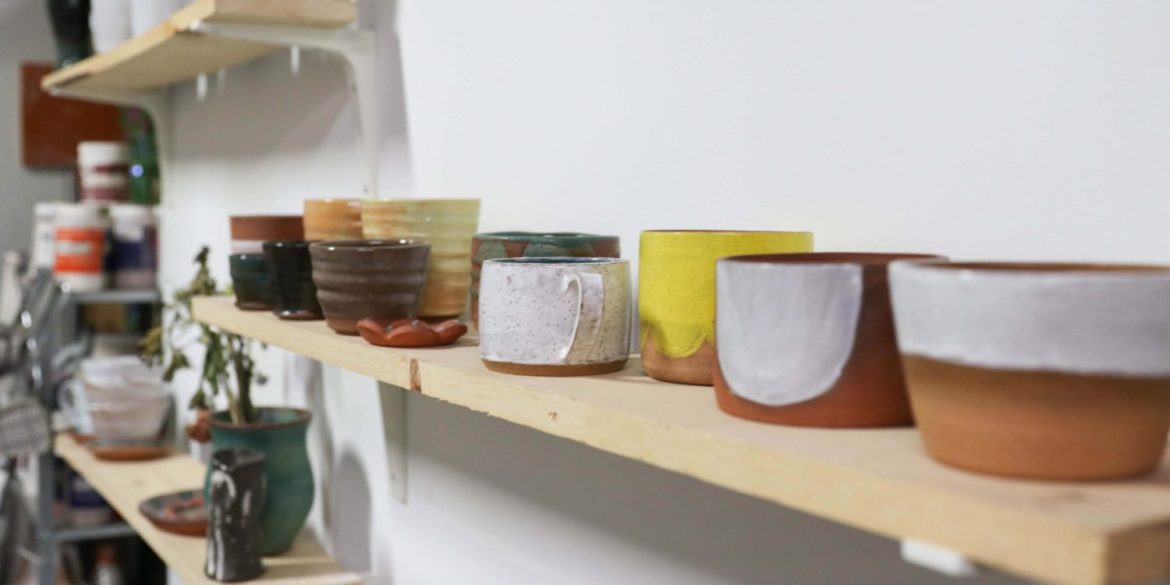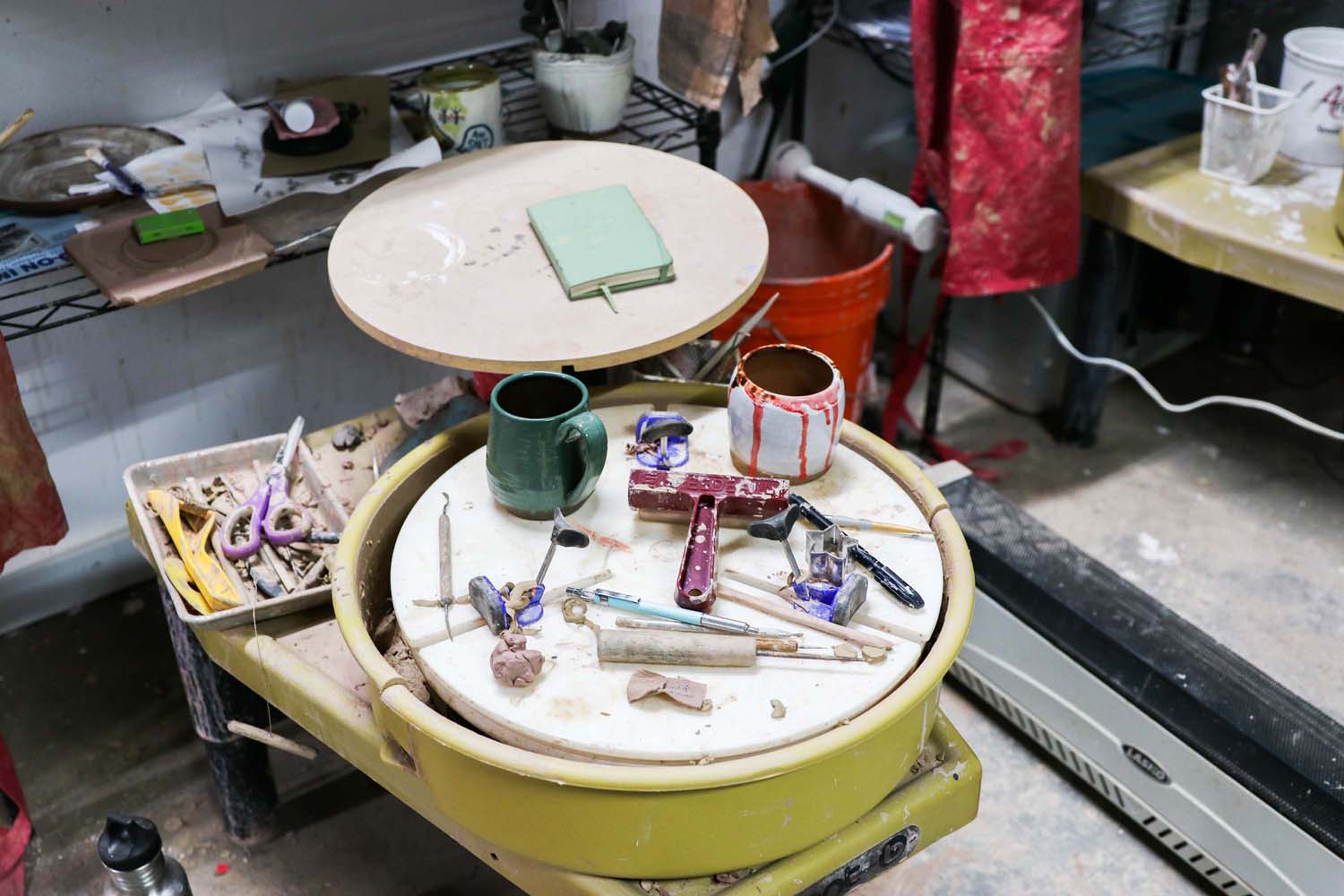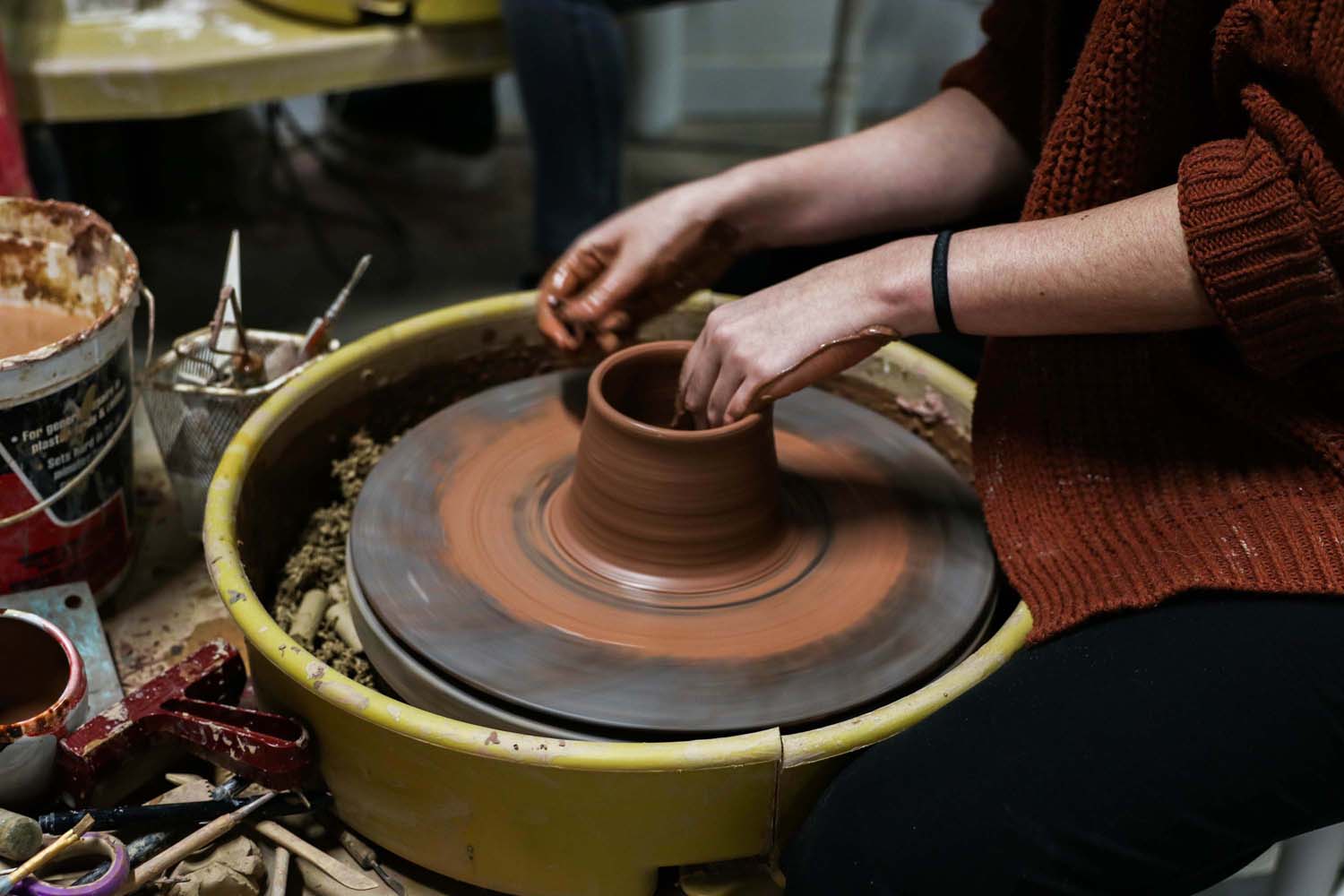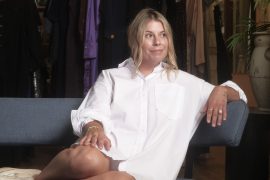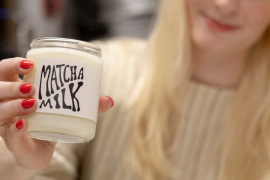Rumple Willow Ceramics is a pair of potters – Alexa Adamson, 25, and Andi Merril, 27. They make functional objects, as well as offer private classes. The duo graduated from Herron School of Art & Design, and in addition to being business partners, they are best friends. Bryn Foreman, a PATTERN intern, had the opportunity to chat with Rumple Willow in their studio at Ruckus Makerspace by Fletcher Park, where they are currently the artists in residence at Graves Co Pottery.
Bryn Foreman: There’s a lot of distance between being friends from college and starting a business together, how did that come about?
Alexa Adamson: Actually, we weren’t friends in college because we didn’t really know each other.
Andi Merril: We met very casually in the ceramics building.
AA: A couple years after Andi graduated, I was getting ready to graduate and I started advertising that I wanted to teach classes. Andi reached out and said that she wanted to get back into pottery, that she knew what she was doing, just needed the space. At the time I had another studiomate, but once that studiomate moved out I was like, “Hey if you want a space, I have it, and it’s a lot cheaper than taking classes every week.”
AM: And you already had Rumple Willow.
AA: Yeah. I was starting Rumple Willow as just myself, but once Andi came on board she was way more interested in helping design and run a studio.
AM: It just kind of made sense. There was a natural progression into it, because I was already doing booths and stuff with her and she asked me, “Do you want to become a part of Rumple Willow?” There was kind of an easy transition into that, and we had become close when I was coming in for my studio time.
BF: Alexa, I know you’re an Aquarius, but Andi what are you?
AM: I’m a Libra.
BF: Do you think that combo creates clashes, or does it enhance your business relationship and friendship?
AM: I think both, but we bond even over the clashes. We are very different but also incredibly similar.
AA: I think the best way to describe us is by looking at our shelves. I have moldy coffee sitting on my shelf, no real organization, it’s just chaos…
AM: Most of my work is very simple and clean: it’s very uniform. Whereas Alexa, she is way more free with her form. I can easily identify any of her stuff on the shelf next to mine because she has way more of a – I don’t want to say “crafty,” because a lot of people try to use that as a negative term in the art world, but you can definitely see her hand in her work way more, while I want mine to be super clean.
BF: Why is “crafty” a derogatory term?
AM: I think “craft” is looked at like, “My mom put this together, and she made this cute art piece!” versus Fine Art.
AA: I think that people think there’s no design involved in craft. Pottery is on a fine line, whether it’s a Fine Art or a craft.
BF: Do you consider yourselves to be fine artists, or craftspeople, or something in between?
AA: I’ve always called myself a ceramic artist. Sometimes I’ll play with sculptural stuff in functional wares, but I don’t necessarily think of myself as a craftsperson. Part of the reason I call myself a ceramic artist, is because I’m also curating shows and I’m trying to collaborate a lot with 2D artists, too. Collaboration is a big part of my work I would say. It’s more fulfilling than just working for yourself.
AM: I battle with what I call myself. I think I more naturally call myself a potter just because typically if I say “ceramic artist” people are like “what does that mean?” but when I say “pottery” people instantly know what I do. Plus, I don’t venture into the sculptural at all. All of my work is cups and bowls, and functional stuff, which I think is more traditionally considered pottery.
BF: Who or what inspires your practice?
AA: I’m definitely inspired by patterns and colors. I take pictures on my phone all the time of inspirational little blobs that I’ll find. Lately it hasn’t been showing in my work because I’ve been making really vanilla stuff.
AM: The stuff that you’re making now is still very much you though, for sure.
AA: I definitely still like incorporating patterns really subtly. I’m inspired by graffiti art, and wheat paste, and seeing the deterioration of things. I like making my pieces look worn and touched, before they’ve ever been touched.
AM: I don’t have a good answer like that for what inspires me. I guess other artists; Alexa inspires me a lot with her drive. I recently went to a modern ceramics pottery show out in Portland that just happened to coincide with the time that I was there. Everything was very sleek and minimal and clean. I was so stoked to be there. If it were up to me, it would look like a machine made all my work.
BF: Where do you see yourselves fitting in with the Indianapolis community?
AM: I think Alexa’s work fits in a little bit more with midwestern pottery, while mine is a little bit more modern compared to the midwest aesthetic.
AA: Yours is more Pacific Northwest.
BF: Can you talk a little bit about your process? Where do you start to end up with a mug?
AA: Everything starts with a lump of clay, which is really exciting. Then we wedge it to get all of the air out, after we’ve wedged it we throw it on a wheel, form it into the shape we want, and then it has to dry for at least a day. If we’re putting a handle on it, it has to dry a little bit longer. We have to trim it to make the foot look even. Then after that we play around with it, if we want any slip or stamps to put into it. Once we do that, then we fire it the first time, after that then we’ll glaze it, fire it again, and typically that’s the last step but we can go even further with more firings and details. There’s a lot we can do with the process. Most of the pieces go through at least two firings.
AM: I play a lot with different glazes. Alexa’s process is a little different from my process if we’re getting down to the nitty gritty. She does a lot more experimenting with different types of glazes, while I do a lot of experimenting with mixing colors. Probably ninety percent of my stuff is one glaze, I just mixed different colors. Overall though it’s the same basic steps for every potter.
BF: Rumplewillow has struggled in the past with finding space. Can you talk about that struggle a little bit, or maybe any solutions you could envision for Indianapolis?
AA: So I started at The Oilwick when I was graduating in 2017. Andi came in the second year, and we made our space beautiful. We had recycled hardwood floors, sweet green walls, natural lighting…
AM: We very much went in there and made it ours. It was devastating when they told us they were closing. We were upset about that.
AA: So The Oilwick closed in April of 2019, and it happened pretty quickly. We had to be out by May, and we had to find a space by then because we had shows lined up for the summer that we needed to make work for. So we put some feelers out to see who would be able to take us in temporarily. Or permanently. Acceleration hit us up first, and that we could use their back storage room. They cleaned out the space, let us stay in it; they were really generous. But there was no air conditioning. It was very warm.
AM: It was essentially a garage that they had been using for storage.
BF: You had a Marilyn Monroe cutout as a door, though.
AA: That was a beautiful door.
AM: I hated that thing.
AA: We stayed in Acceleration for a little bit, and then Rebecca Graves (of Graves Co Pottery) actually reached out to us and offered us a residency here. It was originally planned to be in January of 2020. Then everything came together a lot faster than we were anticipating, and it was like, “surprise! You’re gonna move in in August!” and that was great.
AM: It’s exciting! Because as much as we loved The Oilwick, and having our own private space made how we wanted it to be, it wasn’t made for potters at all. Both The Oilwick and Acceleration were mostly for 2D stuff, but this is the first place we’ve been in that’s designed by a potter for potters. One of our other big issues with finding a place is money. We don’t have a lot of money. We were very very fortunate at The Oilwick with how cheap it was, but with that came a lot of instances where we had to get creative with things like our water disposal. We did look at a few other studios, but they were just so expensive! With Indy having such a growing art community, everything is still very expensive.
BF: Who would you suggest for the next maker of the month spot?
AA: Jasmine Tafoya!
Check out Rumple Willow’s work on Instagram, Facebook, and their website!

